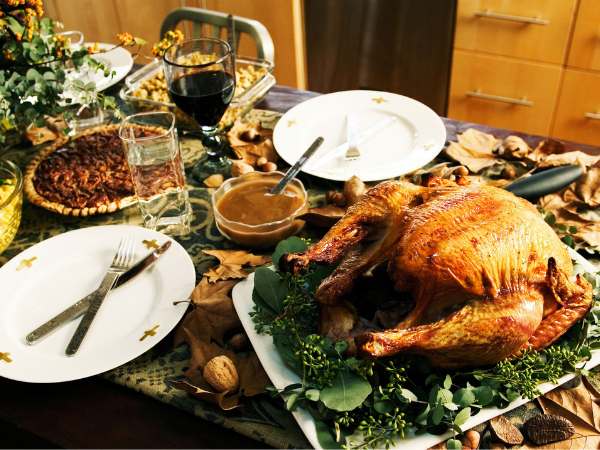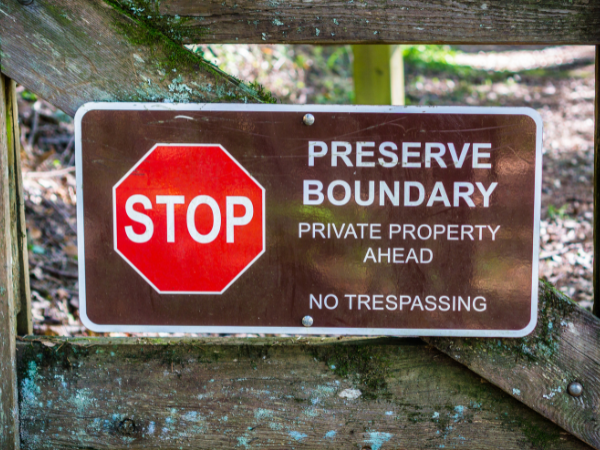Having boundaries is the ultimate act of self-care.
Boundaries characterize every relationship we have, whether familial, romantic, work and even total strangers. Boundaries can evolve over time, depending on the status your relationship with someone; for example: a stranger versus a family member.
As vital as boundaries are for our mental and emotional health, many factors can complicate the boundary-setting process, especially at Thanksgiving, a time when expectations run high.
Maybe you’re visiting family with whom you don’t typically spend much time; you may have traveled a long distance to see them—and you don’t want to “rock the boat” while there. There may be a tendency to slip into childhood roles. For example, you and your siblings start bickering three seconds after you greet each other. Or family members still treat you like a 12-year-old child instead of a 42-year-old mother of two. Maybe your family rehashes embarrassing stories from your childhood, like the time you were 5 and had an “accident” at the mall. Family members can feel entitled to offer unsolicited advice, opinions, or criticism about everything, from your weight (e.g., Keto will help you lose those 30 pounds!) and appearance(e.g., Wow! You’re looking so ‘distinguished’—pointing to your undereye wrinkles—since the last time we saw each other!); to partner status (e.g., Still single? You can kiss ever having kids ‘good-bye’!) and lifestyle choices (e.g., When are you going to get a ‘real’ job?).
As they say: “An ounce of prevention is worth a pound of cure”.
Why would you want to experience Thanksgiving (and the rest of the holiday season) in a state of chronic tension and distress? Setting boundaries is key to enjoying time with the people with whom you most want to experience connection and joy. Feeling uncomfortable or unsure how to set boundaries? See the tips below.
10 Tips for Setting Boundaries at Thanksgiving
1. Know your WHY.
Get clear about WHY you’re celebrating Thanksgiving at a family member’s home, especially if it’s a family member(s) with whom you have a strained or difficult relationship; this helps “set the tone” for your boundaries.
Let’s say, for example, your sister is hosting Thanksgiving dinner at her house this year. Your sister has always been self-absorbed and controlling, and you’re not close with her. But your kids love their cousins (your sister’s kids) and are excited about seeing them; so, you decide to go for their sake. Spending Thanksgiving at your sister’s also affords you the opportunity to visit with elderly relatives you would not otherwise see. Keep this WHY in mind, which will help you….
2. Manage your expectations.
The key is to have realistic expectations. This is not a Lifetime movie! Just because it’s Thanksgiving, challenging relationships or complicated family dynamics will not miraculously change for the better—even if your family is gathering in the same space for the first time in two years after the COVID debacle.
At Thanksgiving, count on history repeating itself. Parents who start bickering after a few glasses of wine. The family friend who overshares at the table. The uncle who goes on his usual political rant. The relative who can’t stop detailing her every bodily ache and pain. The son-in-law who has a short fuse. In addition to dealing with the drama of the usual cast of characters, you might feel pressured to eat more, drink more, or spend more than you feel comfortable.
When you have realistic expectations, you can adjust your boundaries accordingly. This can help you…
3. Just say “No”.
If you don’t feel up to attending a family gathering, where there is constant drama, bickering, fighting, bullying or a barrage of insults being thrown your way, you can decline an invitation kindly but firmly: “No. I can’t make it this year.” Or: “No. Unfortunately, I won’t be able to join you.” Or: “Thank you for the invitation. Unfortunately, no…I won’t be coming.”
“No” is a complete sentence and does not require an attendant explanation.
If your WHY for attending a specific Thanksgiving gathering is for someone else (e.g., your kids), you can:
4. Anticipate triggers.
The best defense is a good offense. When you anticipate potential triggers, you can decide how you will set your boundaries in advance.
For example, if you have a highly competitive and narcissistic cousin who likes to dominate the conversation and constantly interrupts you anytime you try to express a thought or opinion, you could say: “I feel frustrated that I can’t finish my train of thought because I’m being interrupted. Could I please finish speaking before you share your thoughts?” If your cousin ignores this boundary, you can decide whether you stop talking altogether—or leave the table or room.
Speaking of triggers…
5. Have a list of non-triggering “safe” topics at the ready.
The last 2-1/2 years have been steeped in division, whether it’s politics, gender identity, race, immigration, vaccine status, medical freedom, censorship, the state of the economy or our educational system. Decide in advance what topics are off the table—for you.
Instead, identify what YOU feel comfortable discussing, whether it’s the weather; a new recipe you’re trying; music; or your favorite restaurant, movie or television show…and be mindful of sticking to these topics!
This enables you to…
6. Avoid being baited.
If / when you are being needled to respond to a triggering topic, you can say something like: “I don’t talk about XYZ.” Or: “I’m Switzerland today…100% neutral.” Or: “I don’t know enough about that person / topic to have an opinion.”
If the needling continues, you can…
7. Extract yourself from the conversation mentally and/or physically.
Give yourself a time-out and take deep breaths before replying. Visualize being in a calm and relaxed place. Excuse yourself from the room or table. Go for a walk. Help with clearing the table. Help wash dishes. Check on the kids. Take a nap.
8. Prepare yourself around food.
At Thanksgiving, many people step outside their own boundaries around food. The holiday, itself, as well as family members, encourages overindulgence. Most people will break from routine and consume more sugar, more snacks, more starches and refined carbs; drink more alcohol; and/or eat out more often than they normally would.
Stay mindful. If you are following a specific way of eating—e.g., low-carb, gluten-free, dairy-free, Keto, Paleo or you have food intolerances—decide in advance what you will or can eat. You can let your host know in advance about any food sensitivities or dietary restrictions you have so they do not feel “rejected” by your refusal to eat a certain dish(es). You can also decide if there are one or two specific dishes or alcoholic drinks in which you can indulge—without ill effect—whether it’s an extra helping of sweet potato pie, your grandmother’s famous boiled custard, or a cranberry mule. Decide in advance what “treats” you plan to enjoy—rather than indulge in the moment…only to have eater’s remorse for days to come.
If you are vegetarian or vegan and attending a non-vegetarian Thanksgiving gathering, you may want to bring a dish (or two) that you know you will feel comfortable eating. The same applies if you have any other dietary restrictions. For example, if you are following a gluten-free protocol, you may want to bring a dessert, as traditional dessert offerings are typically wheat flour-based.
Food can be a triggering topic. If you have found your way to better health, improved energy, and weight loss through your food choices, you may be in an evangelical mode about helping others “see” how their food choices can potentially change their life. The Thanksgiving table, however, is not the place to proselytize. Refrain from lecturing others about their food choices.
In the same way that you want others to respect your food choices, you have to respect others’ food choices—even if it goes against what you believe.
Keep in mind: people will only make changes around food and lifestyle if / when they are ready—not because you have told them that they need to stop eating sugar, carbs, or meat!
9. Communicate boundaries clearly—and from an “I” perspective.
How you communicate a boundary can make a difference in being heard—or not. Always start from a place of “I feel”; then, say what you need or want. For example, “I feel uncomfortable when you share news about my ex-husband and the woman for whom he left me. I’m still hurting. Please don’t do that. I’d rather not know.”
Avoid making “You did XYZ” statements, like: “You never help out with the kids—even when I’m under the gun with project deadlines. You are so selfish! Can’t you see how stressed out I am?” The person on the receiving end of this statement hears an accusatory tone and criticism—and, as a result, tunes you out. You’re back to square one.
10. Exit stage left gracefully—and early if necessary.
We can clearly communicate our boundaries to others. However, keep in mind: we cannot control how other people will respond to our boundaries. There may nasty pushback, feelings of hurt and resentment or utter disregard for your boundaries—no matter how thoughtfully worded or how clearly you’ve stated your limits. We can only control how wereact to the negative behavior of others.
If boundary violations persist, you can always take your leave. Or, if the boundary offenders are visitors to your home, you can always ask them to leave.
Setting boundaries can feel uncomfortable, yes. But they also give you the psychological freedom to be true to yourself. And that’s something for which you can be truly grateful.



